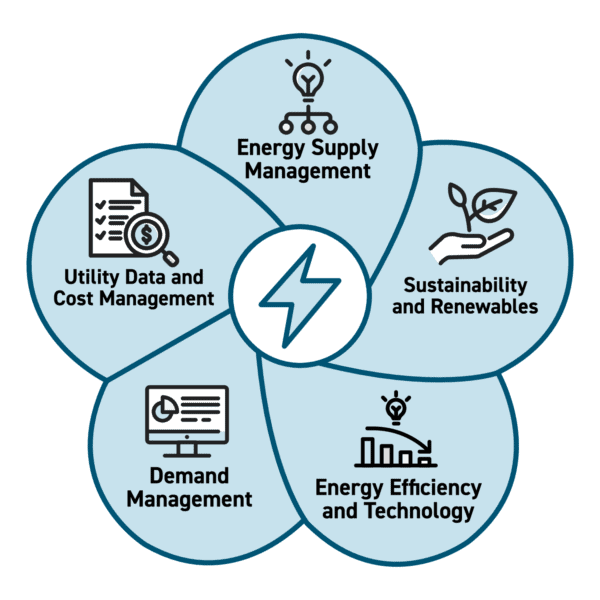Our experience through the last three years has taught us – or reminded us perhaps – that we are living in a world where uncertainty is the norm and a consistent, linear progression of events is not to be counted upon. Thus, the best-laid plans of mice and men often go awry. In few areas have we experienced this more acutely and directly than in the domains of energy management and energy sustainability.
In the half-decade prior to 2020, the landscape for energy and sustainability was marked by relative placidity and steady progress. Energy commodity markets were in a gentle decline with low volatility, and access to renewable energy resources was steadily increasing in what seemed to be a fairly predictable manner, with ever greater resources available at ever lower prices. Under these conditions, planning was generally straightforward, and decisions could be made with relatively little concern for being substantially wrong or second guessed.
Of course, starting in 2020 all that changed. A global pandemic, massive supply chain issues and delays, unprecedented government action, inflation, global conflict, and massive energy market dislocations confounded all expectations and blew massive holes in plans and budgets. Assumptions about stable, low-cost energy supplies and declining costs and increasing access to renewable energy resources were destroyed. Leaders, managers, and practitioners were left with massive problems to solve and more questions than answers.
In our view, though, such adversity can serve as a clear call for us to rework our frameworks for planning, decision-making and action to place them on more stable, robust foundations that can operate effectively in all conditions. A helpful construct that can be applied here is to frame our initiatives and actions in terms of flexible systems rather than hard cast goals.
Goals vs. Systematic Approach
The problem with goals, as they are generally developed and applied, is that they are based on a fixed set of assumptions that generally do not allow for changing conditions. As such, they can serve us reasonably well in stable, linear environments. However, when conditions turn and the environment shifts to non-linearity, we find that our goals are unattainable or no longer relevant, and we are at a loss as to how to operate or what to do next. We also find that there is a lot of second guessing, to which there is not a ready response.
If operating principally through fixed goals is problematic for your organization as described, how then shall you plan and act? Our suggestion is that initiatives and activities should be undertaken through systematic frameworks built on foundational principles stemming from a deep understanding of underlying dynamics, including indicators and measures that can signal current states and potential effects of those dynamics. In addition, this framework should be built on a clear articulation of values and aspirations, and the development of strategies that provides the best opportunity for fulfilling your values and meeting your aspirations in the long-term. Under a systems-oriented approach, strategies are set based on defined actions in response to anticipated conditions and a deep analysis of the underlying situation.
Pivoting Successfully In Changing Conditions
OnSite Partners offers services to analyze and understand long-term trends in the energy markets, including identifying the full range of relevant historical conditions and how they may play out in the future. This allows us to develop strategies that deliver the most successful outcomes across the full range of conditions over time.
Our experts anticipate changes and disruptions and apply proven frameworks that allow us to adjust actions in response to those changes. We analyze trends and identify measures that can signal shifts allowing us to anticipate further changes to protect against threats or seize opportunities. Further, we develop defined rules and practices that have proven to be most effective over the very long term and execute rigorously based on those rules and objectives.
We may recommend shifting emphasis from renewable energy procurement to intensive energy efficiency deployment. In other instances, we may advise focusing on distributed energy resources rather than centralized resources. And there could be shifts between longer-term and shorter-term measures and commitment, all with the strategic company vision in mind.
Thinking and acting through systems – founded on values, principles, a deep understanding of the domains in which we operate, paired with rigorous analytical and decision-making frameworks provide the best opportunities to survive and thrive in an uncertain world. Our minds are the perfect example of a system that was designed to allow us to operate successfully in conditions of non-linearity. We are not programmed with definitive, discrete goals – instead, we are equipped with values, principles, and capabilities of thinking and deciding that can operate across an incredibly wide range of conditions.
Getting Started
These same principles are applied so we offer the best possible outcomes for your organization’s energy management and energy sustainability initiatives. Our energy experts start by partnering with you to understand your business and surveying the landscape to ensure all opportunities are uncovered and nothing gets overlooked. Once opportunities are assessed, we develop a plan, execute and manage all aspects across your portfolio.


Interested in learning more?
If you’ve found this blog informative and would like to learn more, please contact us online.
